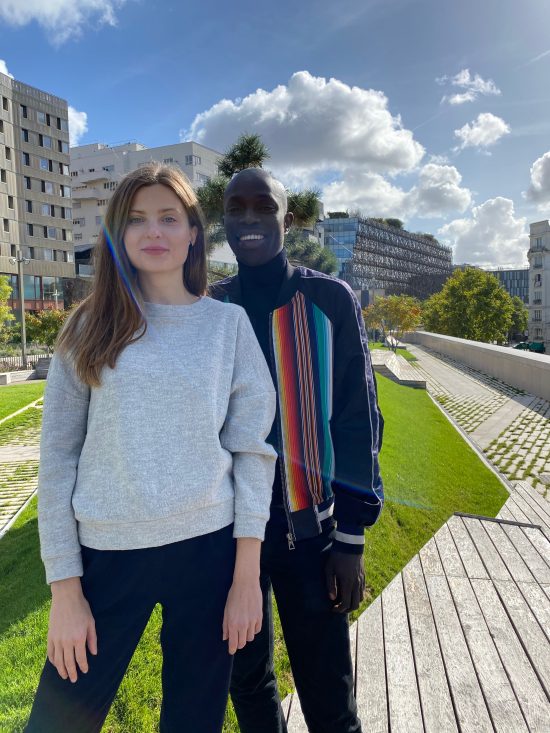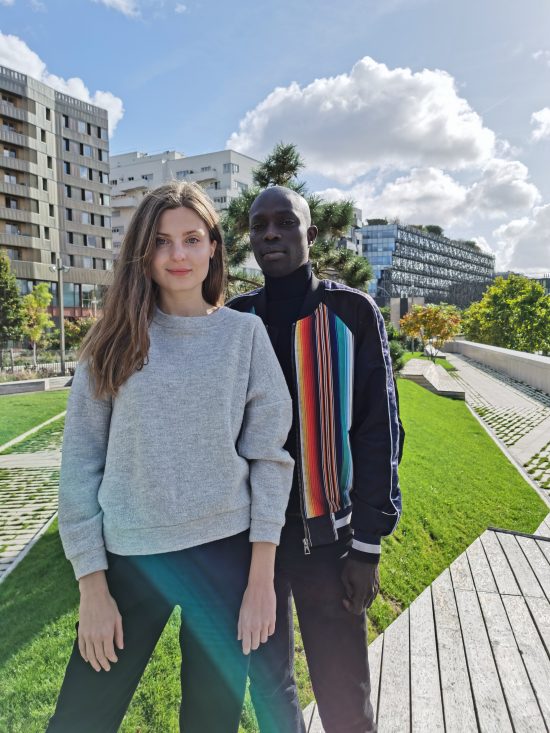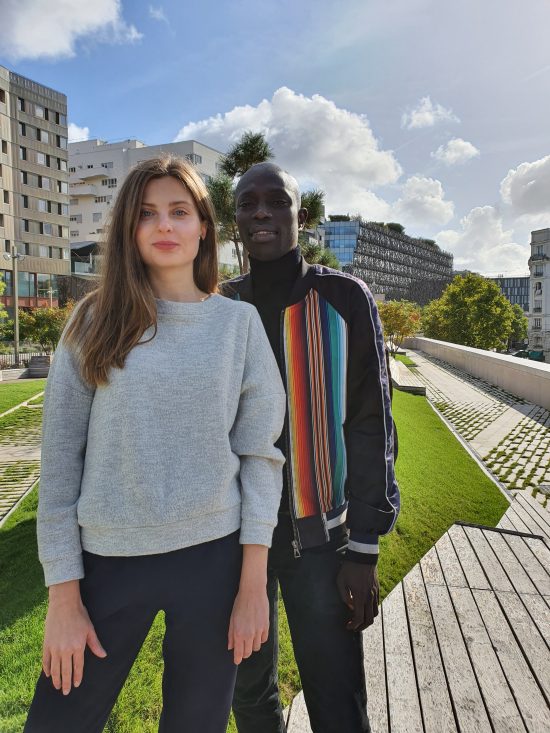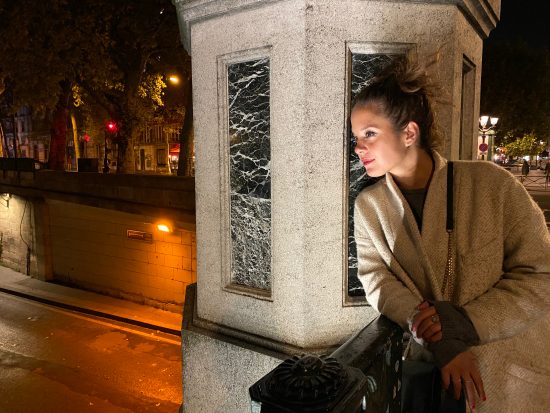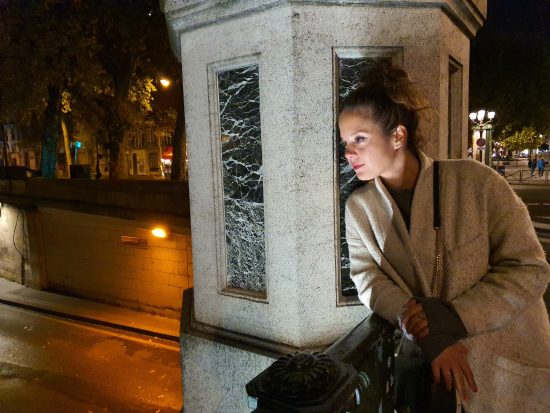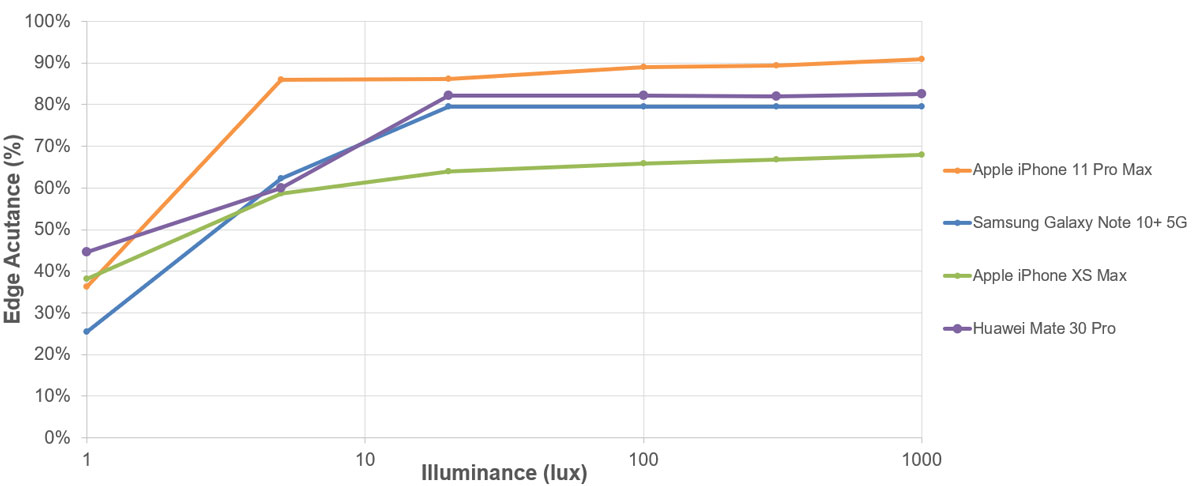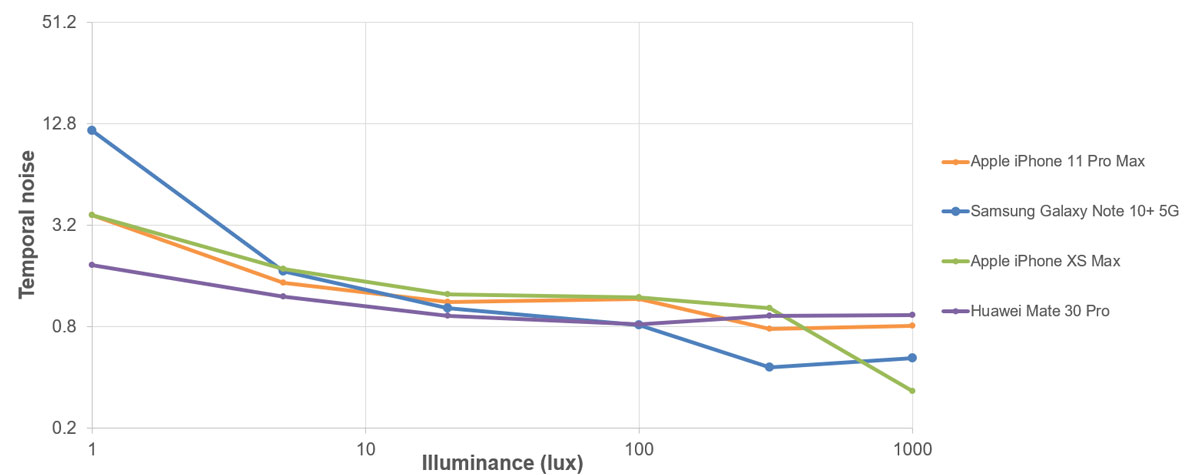The Apple iPhone 11 Pro Max is the Cupertino tech giant’s latest and greatest flagship smartphone, featuring a 6.5-inch Super Retina XDR OLED display, Apple’s latest A13 Bionic chipset, and up to 512GB of internal storage. It’s also the first iPhone to come with a triple-camera setup. Next to the primary wide-angle and the tele-camera, which both offer the same focal length as on the predecessor XS Max, there’s now also an ultra-wide camera with a 13mm-equivalent field of view.
On the image processing side of things, the new Deep Fusion technology uses the chipset’s neural engine and advanced machine learning to perform pixel-by-pixel optimization for better textures, lower noise, and a wider dynamic range. Read our full review to find out how the new components play together. (You can find out more about some of the iPhone 11 Pro Max’s new imaging features, including the redesigned camera interface, seamless zooming in video, live bokeh, and HDR preview, in this previous article.)
Key camera specifications:
- Triple-camera setup
- Primary: 12Mp 1/2.55″ sensor, 26mm-equivalent f/1.8-aperture lens, PDAF, OIS
- Ultra-wide: 12Mp sensor, 13mm-equivalent f/2.4-aperture lens
- Tele: 12Mp 1/3.4″ sensor, 52mm-equivalent f/2.0-aperture lens, PDAF, OIS
- Quad-LED dual-tone flash
- 4K video, 2160p/60fps (1080p/30fps default)
About DXOMARK Camera tests: For scoring and analysis in our smartphone camera reviews, DXOMARK engineers capture and evaluate over 1600 test images and more than 2 hours of video both in controlled lab environments and in natural indoor and outdoor scenes, using the camera’s default settings. This article is designed to highlight the most important results of our testing. For more information about the DXOMARK Camera test protocol, click here. More details on how we score smartphone cameras are available here.
Test summary


With an overall DXOMARK Camera score of 117, the Apple iPhone 11 Pro Max secures itself a top 5 position in our current ranking. Its Photo score of 124 puts it among the best for still images, and it shares the top spot for Video with the Xiaomi Mi CC9 Pro Premium Edition.
The camera performed very well in our tests in pretty much all areas, but some challenges remain. Still images generally show very good exposure. Dynamic range is very wide in bright light and under indoor conditions, but some highlight clipping is still visible in very difficult scenes. Overall, the iPhone is among the very best for exposure; it’s only in very low light when can’t keep up with devices with larger image sensors, such as the Huawei Mate 30 Pro. Like previous iPhone generations, the 11 Pro Max also scores very well for color and is among the best in this category in all light conditions. A slightly greenish cast is visible in some indoor scenes and in our lab tests, but overall color tends to be very pleasant: a slight yellow cast gives some scenes a warm feel and works very well for skin tones in portraits.
Thanks to Apple’s new Deep Fusion that uses machine learning and image stacking, the new iPhone is noticeably improved for detail and textures. It renders fine details such as freckles, hair on pets, and distant foliage very well, making the phone a great option for landscape and portrait photography alike. Only in low light is a drop-off in detail quite evident, with the iPhone unable to keep up with the very best in class. Noise is also improved over the XS Max, but it is still visible in almost all light conditions. Image artifacts are very well under control, though, with only some flare very occasionally visible.
When shooting in bokeh simulation mode, the new iPhone achieves good results, but is not among the best. Slight depth estimation errors are visible in all conditions, but noise on subjects and in the background are improved compared to the XS Max.
Like its predecessor, the iPhone 11 Pro Max comes with a 2x tele-lens. Apple has improved the image quality when zooming, and results at close range are very good. They are not quite on the level of devices with longer tele-lenses, though, such as the Huawei Mate 30 Pro and P30 Pro, and the difference becomes even more obvious at medium and long range: detail drops off when zooming in and noise levels can get quite high in all conditions.
At the other end of the zoom spectrum, the 11 Pro Max is the first iPhone to feature an ultra-wide lens—and its lens has one of the widest angles of view we have seen (13.7mm measured). Image quality results are decent, but like for pretty much all devices, they’re far off the quality of shots from the main camera. Color rendering is nice and dynamic range is OK; moreover, the Apple ultra-wide renders better textures than some competitors… but noise levels are high by comparison. Deformation of faces (anamorphosis) is visible close to the edges of the frame, but it’s fairly well under control, especially considering the wide field of view.
The new iPhone performed well under our new Night test protocol and is among the best, be it with the flash switched on or off, and when using the Night mode. Flash auto mode is not quite as good, though, with some overexposure of portrait shots and sub-par detail rendering.
When switching the camera to video mode, the iPhone 11 Pro Max is capable of producing some of the best footage we have seen on a smartphone, especially when making use of the 4K resolution. Its Video score of 102 is the highest we have seen so far and is matched only by the Xiaomi Mi CC9 Pro Premium Edition.
The iPhone is one of only a few devices to record HDR footage, which results in a very wide dynamic range; moreover, exposure is generally good in most conditions. Color rendering is pleasant and very similar to that of still images, but white balance can be a little unstable when recording indoors. At its 4K resolution, the 11 Pro Max records excellent detail and noise is very well under control in bright light, though it becomes more visible when recording in dimmer conditions.
The video autofocus is very smooth, with good tracking capabilities, and the stabilization system works very effectively in most situations. Only when recording while walking is a jello effect frequently visible in the iPhone’s video clips.
Photo scores explained
The Apple iPhone 11 Pro Max achieves a Photo score of 124 points, putting it into the top ten of the Photo ranking and on the same level as the Samsung Galaxy S10 5G. The Photo score is calculated from sub-scores in tests that examine different aspects of a device’s performance for still images under different lighting conditions. In this section, we take a closer look at how these sub-scores were determined and compare image quality against some key competitors.
Exposure and Contrast (96)
The iPhone 11 Pro Max score for Exposure is among the best we have seen, thanks to very good target exposure in all conditions down to low light, and a very wide dynamic range that allows for recording both highlight and shadow detail in difficult high-contrast conditions.
In the comparison below, you can see that all three high-end devices are capable of capturing a wide dynamic range in outdoor shots, and that the differences are fairly minimal; but in these conditions, the Samsung does a touch better than the iPhone, recording just a smidgen more detail in the sky, while all detail in the sky is clipped in the iPhone and Huawei images.
The situation is reversed under typical indoor conditions, with the iPhone recording slightly better detail in the bright parts of the image than the Note 10+ 5G, and recording the best results we have seen for indoor exposure. This said, though, the differences are pretty minimal overall.
In addition, the new Apple device also records excellent exposures in low light; only the Huawei Mate 30 Pro remains a touch better.
Color (87)
The iPhone’s Color score is close to the best, thanks to pleasant color rendering, vibrant saturation, and accurate white balance in all light conditions. As in previous models, Apple has tuned the camera for images to come out very slightly yellow, which is well within acceptable limits and in most situations makes for pleasant results. It works especially well for skin tones in portrait shots. We observed a slight greenish cast in some indoor and lab images, but overall, the 11 Pro Max color is a noticeable improvement over the XS Max, which suffered from more color casts and instabilities.
You can see the very slight yellowish cast in the outdoor portrait below, which gives the image a pleasantly warm feel. The Note is quite similar to the iPhone, but the Mate 30 Pro opts for a noticeably cooler look. All three devices offer good color rendering in this scene, but the iPhone does the best.
The situation is very similar for indoor conditions. Again, the Apple and Samsung images are very close, but the Note 10+ 5G image has slightly stronger saturation, is a touch more accurate, and arguably offers the best overall color in this comparison. The Huawei image is again cooler and slightly less saturated than the others.
Autofocus (99)
The Apple iPhone 11 Pro Max autofocus performed very well in our lab tests and in real-life shooting alike. It is very quick and locks on accurately in all light conditions; results are also very repeatable. In the comparison graph below, you can see that the iPhone consistently and swiftly delivers good focus with both short and long delays after defocusing the camera, even in low light.
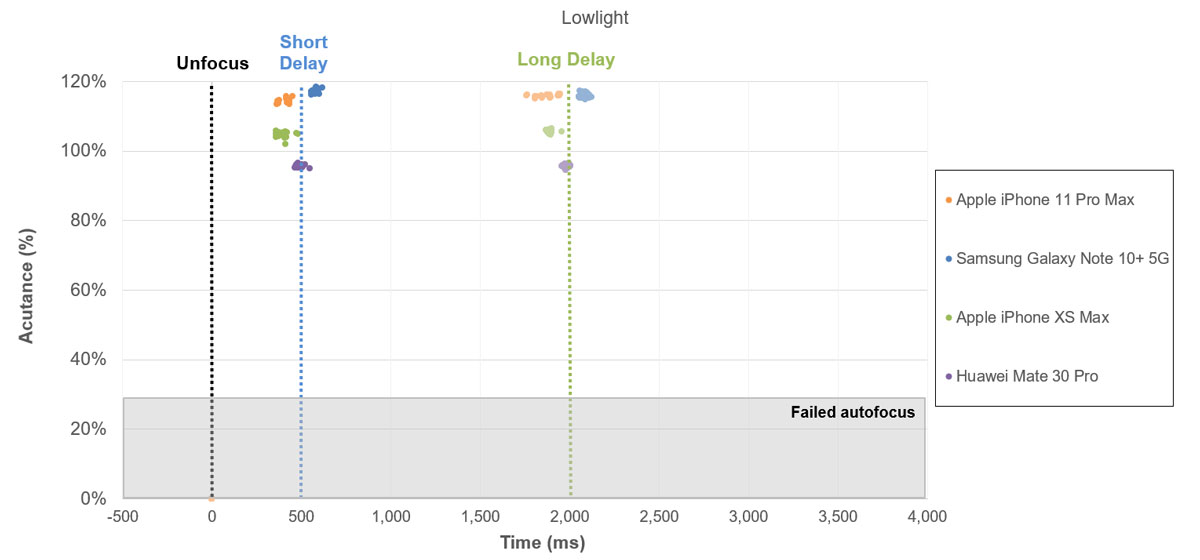
Texture (77) & Noise (73)
Texture is where Apple’s new Deep Fusion image processing really makes a difference compared to previous models. The technology fuses nine frames captured at varying exposures into a single image. The camera continuously buffers image data, and four frames are already captured before you even press the shutter button. Once the trigger is activated, the camera adds a long exposure to the image data pool, and then the Neural Engine takes a fraction of a second to select the best frames and combine them in an optimized way.
As a result, it renders fine detail—for example, distant foliage, pet hair, facial freckles—very well, improving the quality of landscape and portrait pictures alike. In this outdoor comparison, the Huawei Mate 30 Pro does best for detail, but the iPhone comes pretty close, despite a much smaller image sensor. The Samsung renders fine detail noticeably worse than its rivals.
Apple devices aren’t known for low noise levels, and this latest model is no exception. The iPhone 11 Pro Max image processing focuses on detail rather than noise reduction, and noise is visible in areas of plain color in all lighting conditions. This said, it is an improvement over the iPhone XS Max, and its luminance noise is finely grained, which is less intrusive than the more coarse noise we see from some other devices.
Some noise is also visible in the low-light shot below. While the iPhone 11 Pro Max does a good job considering the low light levels, the Mate 30 Pro clearly delivers better detail and lower noise levels. The Note 10+ 5G image also lacks detail and shows a lot of sharpening artifacts, but manages noise very well.
The chart below shows the results of our noise measurements. As you can see the the iPhone 11 Pro Max has improved compared to the XS Max, especially in lower light conditions, but still produces higher noise levels than the best in class.
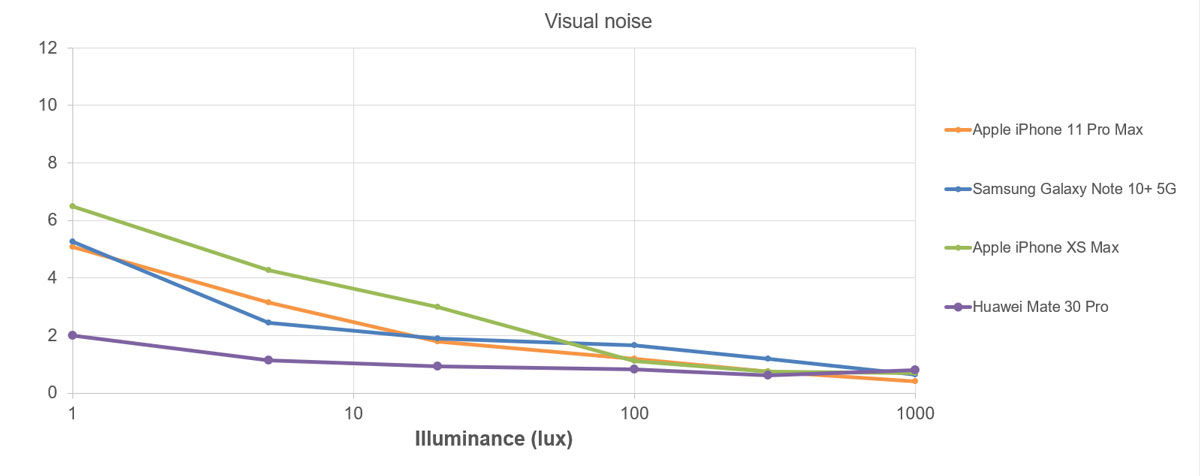
Artifacts (82)
The Apple iPhone 11 Pro Max camera generally controls image artifacts very well, which is why the device achieves a high score in this category. When viewing images at full size, some ringing can be visible along high-contrast edges, but it’s usually not too intrusive. Our testers also found flare artifacts in a small number of our sample images, such as in the shot below, but the iPhone generally controls flare well.
Zoom (74)
Like its predecessor XS Max, the iPhone 11 Pro Max comes with a 2x optical tele-lens that offers a 52mm-equivalent field of view. With this setup, the Apple device achieves good zoom results at close-range distances, and improved image quality over the XS Max, but at medium and long range, it cannot keep up with the 3x and 5x lenses that some competitors come with. Noise is visible in all light conditions, but the iPhone’s zoom score is nonetheless among the best for cameras equipped with 2x lenses.
As shown below, the Apple’s 2x zoom delivers good detail at close range and is pretty much on the same level as the Mate 30 Pro with its 3x tele lens.
Differences become more obvious in the long-range (5x) samples below. The Mate 30 Pro image shows noticeably better detail and is cleaner than the Apple image. The Samsung also squeezes more detail out of the scene.
Bokeh (65)
The Apple iPhone 11 Pro Max achieves a good score for bokeh. It’s a slight improvement over the XS Max, mainly because of lower noise levels, but it is not quite on the same level as the very best competitors.
Some minor depth estimation errors are visible in the sample below, but its portrait mode images show decent depth estimation as well as a nice bokeh shape and gradient, making for quite natural-looking results overall.
We can see in the comparison to the Galaxy Note 10+ 5G that the Samsung device is capable of separating the foreground subject from the background more precisely. Some depth estimation artifacts are visible around the subject in the Apple image. They are much less intrusive in the Samsung image.
Wide (40)
The iPhone 11 Pro Max is the first Apple device to feature an ultra-wide camera. At 13mm (13.7mm measured) it offers one of the widest fields of view currently available, close to such Samsung devices as the Note 10+ and the Galaxy S10+. Overall, the image quality of the ultra-wide camera is quite far from the level of the primary module, but that is true for most current smartphones.


The 11 Pro Max’s Wide score is close to that of the Galaxy Note 10+ 5G (42), but as with the primary camera, the two devices apply a different texture/noise trade-off. The Apple images show more detail than the Samsung, but are generally also noisier. Color rendering is good and anamorphosis (deformation of faces) is visible nearer the edges of the frame, but considering the wide field of view of the lens, it is quite well controlled.
In the indoor sample shot below, you can see that the level of detail in these conditions is not on the same level as the main camera, but the Apple is slightly better than its Samsung rival. Noise is less visible in the Samsung image, however.
Night (53)
With an overall Night score of 53 the iPhone 11 Pro Max is not far from the best devices we have tested in this category—and indeed, the iPhone is one of the very best with the flash switched off. Images show good exposure as well as natural white balance and color rendering, even in difficult mixed lighting situations, and good skin tones in portrait shots. On the downside, we have seen some clipping in illuminated areas of the scene and some slight ghosting on moving subjects.
Flash-auto mode, on the other hand, leaves some room for improvement. The camera captures fairly good detail in this mode, but noise is quite visible and the flash sometimes triggers for landscape shots where it cannot help illuminate the scene. We also saw some overexposure on faces in portrait shots, resulting in highlight clipping on skin tones and inaccurate color rendering.
The camera performs well with the flash forced on, though, showing an improvement over the XS Max. In both total darkness and low ambient light, white balance and exposure are accurate, but images show some noticeable light fall-off towards the edges. Our testers also observed some slight exposure variations across a series of images shot at 0 lux.
The Apple’s Night mode is one of the best we have seen so far and beaten only by Google’s Night Sight. It is capable of achieving better image quality in certain situations than standard flash-off mode, and therefore earns the iPhone 11 Pro Max some extra points in the Night category. Color rendering is generally pleasant and noise levels are lower than for pictures captured at default settings. However, if the camera detects faces, it seems to apply a different kind of image processing that renders detail on faces noticeably soft.
Video scores explained
With an overall Video score 102 points, the Apple iPhone 11 Pro Max ties the Xiaomi Mi CC9 Premium Edition for the best Video score in our database. The overall Video score is derived from performance and results across a range of attributes in the same way as the Photo score: Exposure (90), Color (90), Autofocus (93), Texture (75), Noise (79), Artifacts (85), and Stabilization (94).
At default settings, the iPhone 11 Pro Max records video at 1080p Full HD resolution and 30 frames per second, but it achieves the best results at 4K resolution. Those users who frequently switch between video resolution and/or frame rates will be happy to see that Apple has made this process very easy. As you can see in the videos below, you can simply tap on a couple of buttons on the video screen during recording.
Video clips generally show good exposure, and thanks to video HDR, they have a very wide dynamic range, capturing excellent detail in both highlight and shadow regions of the frame. This said, we also observed some tone mapping instabilities that can cause a slight flicker effect in the sky and on clouds or reflective surfaces. In very low light, exposure is not quite as bright as the best in class.
The iPhone’s wide dynamic range can be seen in the comparison clips below. Both the Huawei and Samsung show clipping in the bright parts of the frame while the Apple device maintains highlight detail very well.
The Apple camera achieves a good score for video color. Like for stills, color rendering is pleasantly warm, but white balance can occasionally be a little unstable, with too many too-fast changes in variable light conditions. Noise is visible when recording in low light and under typical indoor conditions, but it’s well controlled in bright light and overall in line with the competition. When shooting in 4K mode, the camera records high levels of detail in bright light and indoors, but detail drops off in low light, as can be seen in the chart below.
The iPhone controls artifacts very well, resulting in a high score for this category. Ringing is very well controlled, and only some judder is visible when panning (that last is true for any camera recording at 30 frames per second, however).
The autofocus system is not the fastest we have seen, but it’s fast enough. Further, it is very stable, operates very smoothly, and provides good tracking. As with previous iPhone generations, the 11 Pro Max comes with very good video stabilization; but this said, it scores slightly lower than the predecessor XS Max in this category, mainly because of a more visible jello effect. When recording while walking, deformations are visible on trees, buildings, and other objects towards the edges of the frame. The effect is much better controlled at the center of the frame, however, and overall stabilization does a very good job.
Conclusion
Previous Apple iPhone generations have always been among the best smartphones for imaging, and the iPhone 11 Pro Max is no different. It matches our top score for Video, recording video clips with good detail, a very wide dynamic range, and smooth stabilization in most circumstances. Its still image results also put it among the best, thanks to consistently good results from the primary camera, which is now accompanied by a very capable ultra-wide lens with one of the widest fields of view we have seen. Bokeh simulation mode and zoom performance at long range are not quite up with the very best, but if those areas are not top priorities, the new iPhone is an easy recommendation for any mobile image creator, especially those who are already invested in the iOS ecosystem.
Photo
Pros
- Good levels of detail in most test conditions
- Accurate target exposure and wide dynamic range in most situations
- Fast, accurate, and repeatable autofocus
- Vivid and pleasant colors
- Very wide ultra-wide lens, with good detail and dynamic range, and well-controlled chromatic aberrations
- Good zoom performance at close and medium range
Cons
- Noise visible in all light conditions
- Loss of detail in long-range zoom shots
- Ringing in outdoor images
- Lack of detail in flash images
- Strong yellow cast under low warm light
- Lack of detail and noise in ultra-wide images
Video
Pros
- Wide dynamic range
- Good detail and well-controlled noise in outdoor and indoor footage
- Vivid and pleasant color
- Effective stabilization
Cons
- Jello effect when recording while walking
- White balance instabilities indoors
- Noticeable autofocus stepping when tracking
- Aliasing is occasionally visible
A note about image formats for this review: The iPhone 11 Pro Max records photographs in the DCI-P3 colorspace, which their displays also use. DCI-P3 is newer and larger than the sRGB color space that most devices use. So to ensure that the images we used in the review display properly on a wide variety of browsers and devices, we converted the originals from DCI-P3 to sRGB using Photoshop (which is why the published test photos show Photoshop as the creator). This can slightly reduce the richness of color in some cases from what you would see when viewing the original images on a DCI-P3-calibrated display with appropriate software. We also captured the original images using the new HEIF (High-Efficiency Image Format), but then converted them to very high-quality JPEGs for viewing in standard browsers and image editing software. (HEIF is very similar to JPEG, but provides better compression for similar image quality, so the conversion makes the sample image file sizes larger than they were when shot.) Please note, however, that unlike our test images, some of the comparison photos used in this review were shot in JPEG and are used as-is for illustrative purposes; they were not used to compute scores.
The post Apple iPhone 11 Pro Max camera review appeared first on DXOMARK.























